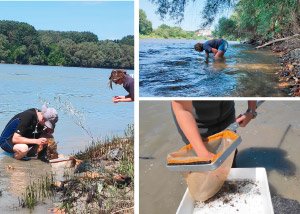Introduction to the Joint Danube Survey
The Joint Danube Survey 5 (JDS5) represents a significant milestone within the domain of environmental monitoring. As the largest coordinated surface water monitoring initiative globally, it reflects the collaborative efforts of various countries along the Danube River, with a primary focus on assessing the health of aquatic ecosystems and the quality of water resources. The survey is conducted on a six-year cycle, allowing for consistent collection and analysis of data, making it a vital tool for policymakers, environmentalists, and researchers alike.
This comprehensive project gathers insights from experts across multiple disciplines and nations, highlighting the importance of international cooperation in addressing multifaceted environmental challenges. The primary objectives of JDS5 include the evaluation of water quality, the assessment of biodiversity, and the identification of emergent environmental threats. This year’s edition places particular emphasis on pressing issues such as microplastics proliferation, chemical pollutants, and their cumulative effects on both aquatic life and human health.
Through systematic sampling and analysis, the JDS5 aims to provide a clear snapshot of the current state of the Danube River and its tributaries, enabling stakeholders to make informed decisions concerning water management and conservation strategies. The data collected during this survey is crucial for developing effective policies aimed at protecting the Danube Basin’s aquatic environments while promoting sustainable usage of its resources. Moreover, the survey’s results will support the implementation of targeted actions necessary to mitigate the threats faced by its ecosystems, ensuring the protection of biodiversity and water quality in this vital transboundary waterway.
Key Highlights of JDS5
The Joint Danube Survey 5 (JDS5) represents a significant milestone in environmental monitoring and cooperation in the Danube River basin. One of the most remarkable features of this initiative is the extensive collaboration among 14 countries encompassing the Danube region. This unprecedented partnership exemplifies a collective commitment to preserve and enhance the ecological health of the Danube River and its tributaries. Each participating country contributes unique data and expertise, facilitating a comprehensive understanding of transboundary water quality and ecosystems.
Involving over 1,000 experts from more than 100 institutions, JDS5 relies heavily on scientific rigor and multidisciplinary approaches. These experts encompass a diverse range of fields including hydrology, biology, and environmental science, thereby ensuring that the initiative is grounded in robust scientific methodologies. By pooling resources and knowledge, JDS5 is not only enhancing the quality of water monitoring but is also setting a precedent for international cooperation in environmental governance.
Moreover, JDS5 operates 108 monitoring sites that stretch over an impressive 2,800 kilometers—covering both the Danube River and its tributaries. These sites are strategically chosen to provide a comprehensive snapshot of the water quality across different regions, accounting for variations due to geographical, meteorological, and anthropogenic factors. The data collected from these monitoring sites will be instrumental in shaping future policies and operational strategies aimed at safeguarding water resources.
In addition to scientific engagement, JDS5 also embraces the concept of citizen science by involving schools and communities in water sampling initiatives. This engagement not only amplifies public awareness about critical water issues but also fosters a sense of collective responsibility toward environmental stewardship. Together, these elements underscore the holistic approach JDS5 takes in addressing water quality and ecological conservation across the Danube Basin.
Impact on Policy and Environmental Strategies
The Joint Danube Survey 5 (JDS5) represents a significant milestone in the realm of surface water monitoring and has far-reaching implications for environmental policies and strategies. As a comprehensive initiative targeting the extensive Danube River Basin, the survey’s results are poised to inform and shape the future of water management practices, particularly concerning the 2027 Danube River Basin Management Plan. This plan is critical for ensuring that the water bodies within the basin are managed sustainably and effectively.
The findings from JDS5 will provide essential data regarding the current state of water quality and biodiversity across the Danube River. These insights will enhance our understanding of contamination sources, their impacts on aquatic ecosystems, and the effectiveness of existing management strategies. As a result, policymakers will be better equipped to address pressing contamination issues, utilizing data-driven approaches to implement corrective measures. The integration of these findings into policy frameworks can facilitate a more evidence-based response to environmental challenges faced by the Danube and its tributaries.
Moreover, the outcomes of the Joint Danube Survey will not only guide immediate actions but also set the groundwork for long-term environmental regulations. The survey’s comprehensive assessment may uncover trends and patterns that necessitate new policy interventions or adaptations in existing regulations. By fostering collaboration among countries in the Danube Basin, the report’s results can encourage cohesive strategies aimed at sustainable ecosystem preservation. This collaborative approach is essential for achieving both ecological goals and compliance with international environmental standards.
In summary, the JDS5 will play a crucial role in shaping the future of environmental management in the Danube River Basin, influencing policies aimed at improving water quality, mitigating contamination, and securing ecological integrity for generations to come.
Voices of Leadership: Quotes from Key Figures
The Joint Danube Survey 5 (JDS 5) has emerged as a pivotal initiative in promoting the health of the Danube River, and various leaders have shared their insights on its significance. Norbert Totschnig, the Austrian Water Minister, expressed a poignant view of the project by stating, “The Joint Danube Survey embodies our collective commitment to understanding and protecting the Danube River. It enables us to gather vital data, fostering informed decisions that transcend national borders.” This belief in cooperation highlights how JDS 5 serves as a platform for gathering critical environmental data, which is crucial for informed policy-making in water management across multiple countries.
Birgit Vogel, representing the International Commission for the Protection of the Danube River (ICPDR), emphasized the importance of collaboration between nations. She noted, “The success of the Joint Danube Survey lies in the unity among participating countries and institutions. This initiative not only allows for comprehensive environmental assessments but also strengthens our ties as we work collaboratively towards sustainable water governance.” Her words resonate with the overarching goal of the JDS 5 to foster transboundary cooperation, essential for addressing shared water-related challenges effectively.
Similarly, Lidija Globevnik, the ICPDR President, articulated the significance of public engagement in water conservation. She stated, “Through the Joint Danube Survey, we are not only focusing on scientific research but also on enhancing public understanding of the Danube’s ecosystem. It is vital that communities recognize their role in the preservation of this waterway.” This sentiment emphasizes the connection between scientific inquiry and community involvement, asserting that safeguarding the Danube requires the collaboration of both experts and the public.
These reflections from influential figures underscore JDS 5’s role as a critical channel for scientific research and community participation, amplifying efforts toward water conservation and sustainable management of the Danube River. The insights provided by these leaders illustrate a commitment to enhancing the health of the Danube ecosystem while fostering a shared responsibility among nations and communities alike.

